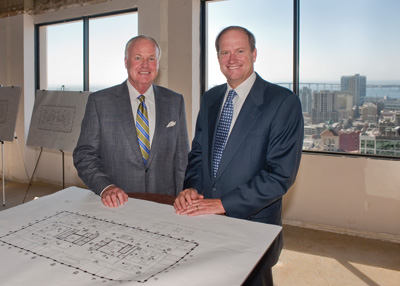Landlords are wooing prospective tenants with free rent, added tenant improvements, extra square footage
It’s a tenant’s market!

By Manny Cruz
Not many Downtown office tenants are as fortunate as the law firm Procopio, Cory, Hargreaves & Savitch, which decided to abandon its 40-year residency at 525 B St. — the Union Bank building — for more spacious quarters across the street at 530 B St., the 22-story tower commonly called Golden Eagle Plaza. The move will take place next May, after Hines, the building’s owner, finances millions of dollars worth of tenant improvements — a meditative garden for one — for Procopio’s stable of 95 attorneys and support staff, a total of 200 working people.
To top it off — no pun intended — Procopio, a 63-year-old firm with another office in Carlsbad, will get to name the building with a sign at the highest point of the building, visible from many areas of Downtown.
Although the poor economy has significantly affected the office leasing market Downtown and countywide — rental rates are declining while vacancies are increasing — Procopio’s decision to relocate wasn’t made in haste. “While the actual decision was made this spring, we’ve been studying the market for a decade,” says Tom Turner, managing partner of Procopio. “The market is struggling, but that’s a good time to be a good tenant.”
Turner says no one should get the idea that the relocation reflects any change in the law firm’s relationship with Union Bank. “We value our relationship with Union Bank; it is our bank,” he says. “It’s just that across the street had more to offer.”
Such as larger floor plates — 19,500 square feet in Golden Eagle Plaza compared to 8,600 square feet in the Union Bank building. And more parking for its people — more than twice as much per square foot, according to Turner.
Craig Irving, principal of Irving Hughes, who represented Procopio in its lease negotiations with Hines, says the law firm will get more space — 100,000 square feet — in its new location, and it will be less expensive space, although the financial terms were not disclosed.
In the Union Bank building, Procopio’s people work on nine floors. “We were just spreading out and spreading out,” says Turner. At 530 B St., Procopio will take occupancy of the top four floors, one additional high-rise floor and lower floor space. The four top floors will be connected by an internal stairwell with a glass skylight, allowing natural light to spill down through all four floors. The meditative garden, to be located at the southeast corner of the 22nd floor, will be open to the sky and have plants, a water feature and sitting area.
In such a dismal economic climate, Procopio’s relocation decision is seen as prescient by many brokers. “They’re taking perfect advantage of the market,” says Frank Wright, principal of Grubb & Ellis|BRE Commercial. “Although they’ve been in that place for 40 years, the building is a Class C building with regard to its small floor plates. This gives them the opportunity to rework their physical layout and they get the building signage.”
“When you become large like Procopio,” adds Irving, “you develop a lot more synergy with a larger floor plate.”
Representatives of the large brokerage houses — Jones Lang LaSalle, Grubb & Ellis, CB Richard Ellis, Irving Hughes — all say the office leasing market Downtown is favoring tenants, as landlords, fearing rising vacancies, are offering a variety of concessions.
Randall Wood, executive vice president of Jones Lang Lasalle, puts the Downtown office vacancy rate at about 15 percent. Total Class A and Class B office space Downtown is about 10.3 million square feet.
“We’re seeing outright rate reductions, we’re seeing an increase in tenant improvement contributions from landlords,” says Wood. “In some cases, landlords are giving cash incentives. Some offer free rent — one month of free rent for every year in the term of the lease. Tenants may prefer not to take the free rent and instead ask for a rental rate reduction or greater tenant improvement allowance if they want to upgrade their offices.”
Tenants also are asking for shorter term leases. “The average lease term is five years and not many are more than 10 years,” says Kraig Kristofferson, senior vice president of CB Richard Ellis. “We’re seeing some people asking for only two or three years and taking the space as is, without any big improvements.”
Although the Downtown market may be giving tenants some breaks, it is not an entirely rosy picture. “The real difficulty, with the economy being as it is, is that tenants are unsure about their future, talking about downsizing,” says Kristofferson. “This would be an ideal time for the tenant to get a long-term commitment from a landlord with rents reduced significantly.” Kristofferson primarily represents landlords during lease negotiations.
Cushman & Wakefield’s August report on the Downtown market reflects the affects the sour economy has had on tenants and landlords. It puts year-to-date office absorption as a negative 33,804 square feet despite nearly 300,000 square feet in leasing activity. “The second quarter saw over 170,000 square feet of leasing activity and this trend is expected to continue as we’re currently tracking over 500,000 square feet of tenant activity in the Downtown market,” says Matt Carlson, associate director with Cushman & Wakefield. He adds that, while the activity is somewhat encouraging, it is not expected to outpace the large blocks of inventory expected to return to the market over the next several quarters from downsizing or failing companies as well as a handful of tenants leaving Downtown entirely.
The downward trend for both asking and effective rental rates continued, the Cushman & Wakefield report said, standing at $2.15 and $2.14 on a full-service basis, respectively.
Kristofferson says he has seen some tenants moving from Class A to Class B offices because of the softening market, but there are tenants moving up in class because the Class A rates have become more attractive. (Class A generally means the property is high quality and is either new or in new condition. Class B offices are in good condition and tend to command a lower rental rate and may not have all the bells and whistles of Class A property.)
Karina Juarez, an associate with the Brown Law Group in Downtown, who represents tenants and landlords in leasing disputes, says she has personally renegotiated an existing lease for a tenant client that essentially doubled the initial square footage at no additional cost. “We signed a new five-year lease with a 47 percent increase in square footage,” says Juarez, noting that there was a significant vacancy in the building.
Colliers International in San Diego, recognizing the problems tenants face in this economy, has launched a Website — sdsublease.com — to assist tenants in reducing their lease obligations. “Both landlords and tenants are focused on occupancy now,” says Michael Glavan, a consolidation specialist with Colliers. “Building owners can’t afford to have huge blocks of vacant space sitting on the market, and tenants need to reduce overhead costs and possibly downsize without going through a costly relocation.” The Website offers a marketing medium for tenants to dispose of their excess space. Glavan adds that Colliers also can work with landlords to restructure rental rates through free rent or lower rent in exchange for lease commitment extensions.
The future of the Downtown office market is murky. Some analysts, like Kristofferson, are “cautiously optimistic.” “It will probably be through 2010 before we see leasing rates really going back up,” he says. “We’re seeing fewer people trying to give back space and downsizing, but it’s still going to be a difficult market. Some research firms project negative rent growth through 2010.”
Wood is not as optimistic as some analysts. “Many of us here are thinking 2011 (for the beginning of a recovery),” says Wood. “Look no further than the employment rate. Until we see an economic recovery where people are back to work, we see the demand for office space to continue to be down.”
Irving sees a formidable problem that all tenants and landlords must contend with in the Downtown office market — whether in good times or bad — and one that the Procopio law firm solved by its decision to relocate. And that’s the scarcity and the increased cost of parking. “While rental rates have declined sharply, and will continue to drop, parking rates have not,” says Irving. He puts the average cost of parking Downtown at between $180 and $200 per space per month — a big chunk out of a tenant’s budget.
“I’m a big booster of Downtown; it’s a great place to live, work and play,” says Irving, “but nobody has really addressed the scarcity of parking and the cost of it.” z

